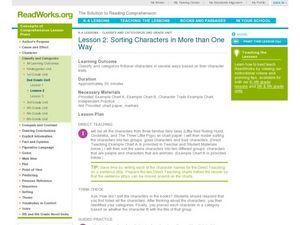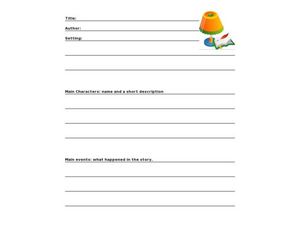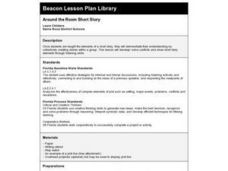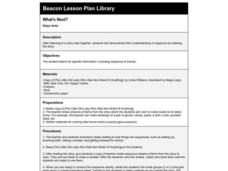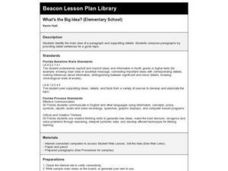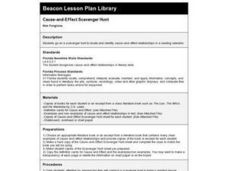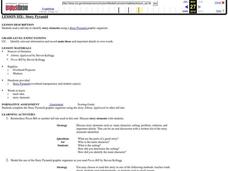Curated OER
Lemony Snicket Series Comes to an End (Unfortunately)
An informational text about Lemony Snicket leads to a discussion of the books class members have read in the Series of Unfortunate Events series. Children then compare and contrast the settings, plots, and characters in the...
Curated OER
Sorting Characters in More Than One Way
Introduce your class to characterization. Familiar story characters are sorted into "good" and "bad" categories based on the characters' personalites and actions in the story. The class discusses and describes characters they have read...
Curated OER
Writing Template
Give your writers the chance to organize their thoughts before writing a story with this graphic organizer. Simple and easy to understand, the lines provided prompt elementary learners to write the main characters, main events, and...
Curated OER
Identifying Story Elements
Help your class identify story elements. They will discuss character, setting, problem, and solution after reading a story. A graphic organizer will help them to identify various elements with guided practice and independent practice...
Curated OER
Elmer by David McKee
Students explore individual differences. In this literacy and self-esteem lesson, students listen to the story Elmo by David McKee, then describe what characteristics make Elmo special. Students complete a T chart showing how Elmo looked...
Curated OER
Build a Tasty Sandwich
The subject doesn't sound to interesting, but with a child's imagination even a trip to the store can be an adventure. The class writes a narrative story about a trip to the store. They organize their stories to include an introductory...
Curated OER
The Memory Invention
Young writers edit their writing to make sure it shows good meaning and clarity. In this writing lesson, learners are given a variety of "What If?" scenarios to choose from as writing prompts. A class discussion ensues, which focuses on...
Curated OER
Around the Room Short Story
Collective story writing is a great way to reinforce the concept of story elements and collaborative learning. Young writers discuss story elements such as, setting, character, action, climax, conclusion, foreshadowing, dialogue, and...
Curated OER
Tear Into a Story
Learners retell a story using the correct sequence of events for a story they have listened to five times. They identify the characters and the setting for the story, and sequence the events using a dissembled copy of the book.
Curated OER
What's Next?
Children listen to the story, The Little Old Lady Who Was Not Afraid of Anything, and discuss the sequence of events. They create a booklet, sequencing the events in the correct order.
Curated OER
Story Elements
Review story elements with your class using this resource. Learners can take a story they have read as a class and identify story elements. They focus on characters, setting, the introduction, and plot. Then, they use graphic organizers...
Curated OER
Reading Comprehension
After listening to a story learners engage in a kinesthetic activity to answer comprehension and critical thinking questions. Finally, the students identify three main facts about the story. Extensions include a fact and opinion...
Curated OER
What's the Big Idea
Discuss the concept of main idea in a story or other reading material. Middle schoolers identify the main idea in a passage using a technique that eliminates unnecessary words not relevant to the main idea.
Curated OER
Cause-and-Effect Scavenger Hunt
Examine and discuss examples of cause-and-effect relationships. They locate and identify cause-and-effect relationships in their current reading selection.
Curated OER
The Frog and the Scorpion
What a creative means to discuss main characters and adjectives. Learners read a short story about a frog and a scorpion, discuss the characters' actions, and identify adjectives. This technique could be used to review a variety of...
Curated OER
"Swamp Monsters" by Mary Blount Christian
Using the book Swamp Monsters by Mary Blount Christian, young readers discuss key vocabulary terms and make predictions about swamp monsters. They complete a Cloze activity, explore past-tense verbs, and categorize vocabulary words.
Curated OER
Identifying Plot Conflicts
Fifth graders identify plot conflicts in the text. In this plot conflict lesson, 5th graders read Dogs Don't Tell Jokes and recognize examples of character vs. self and character vs. character.
Curated OER
Genre Lesson: What is a Mystery?
Students identify the characteristics of the genre of mystery. In this genre lesson, students discover the elements of a mystery story and begin recording the elements on a class chart of the book entitled Two-Minute Mysteries: The...
Curated OER
Predicting a Solution to a Problem
Learners explore story structure. In this story structure literacy lesson, students listen to the story Ruby's Wish by Shirin Yim Bridges, stopping at points to identify a problem and predict possible solutions which are then written on...
Curated OER
Compare The Hat and The Mitten
Second graders compare two books they have read, The Hat and The Mitten. In this compare and contrast lesson, 2nd graders review the author and illustrator of the books and discuss the main characters and problem. Students use Venn...
Curated OER
Making Inferences
Students discover how making inferences helps people solve problems. In this inference lesson, students read a story aloud and discuss problems as they occur in the story. Students work in small groups and use events in the text to infer...
Curated OER
Story Pyramid
Students read tall tales to identify story elements. For this story elements lesson, students read about Johnny Appleseed and Pecos Bill and use graphic organizers to record information. Students read in small groups,...
Curated OER
Story Elements
Third graders identify story elements. In this story elements lesson, 3rd graders look at main idea, characters, point of view, theme and setting. They create a five paneled comic strip from a book.
Curated OER
What Can I Write About When I Can't Think of Anything To Write About?
Third graders write, illustrate, and publish a collaborative story. In this writing lesson, 3rd graders review story elements by reading stories written by professional authors and other students. They work in groups to write a...



